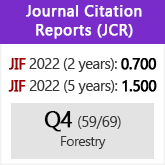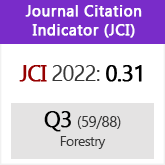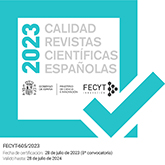Susceptibility to Phytophthora cinnamomi of six holm oak (Quercus ilex) provenances: are results under controlled vs. natural conditions consistent?
Abstract
Aim of study: Quercus forests are being affected by severe decline and mortality. The oak decline is associated with the soilborne pathogen Phytophthora cinnamomi (Pc), among others. This work aims to determine if Quercus ilex growing in Pc-infested soils show mortality differences according to their provenance in the field. It also evaluates whether the most tolerant provenances are those with the greatest constitutive chemical defences.
Area of study: Acorns from six Spanish National Parks with natural presence of Q. ilex were collected for sowing in the greenhouse and later be planted on soils naturally infested by Pc in the surroundings of Plasencia, western Spain.
Materials and methods: Seedlings were planted in four field plots located in two areas with oak decline: 153, 156, 157 and 155 plants in plot I, II, III and IV, respectively. The presence and infection of Pc was confirmed before their installation and during the experiment. Symptoms, regrowth, mortality and development was recorded for four years.
Main results: There was a high mortality (56.0-80.5%) with differences among provenances. The most tolerant provenances in the field coincided with those identified under greenhouse conditions in a previous test. Provenances with higher constitutive condensed tannins better tolerate the pathogen under both conditions. In the southern provenances, some families with higher tolerance and, therefore, candidates for use in reforestation programs in areas infected by Pc, were identified.
Research highlights: The restoration of Pc-affected areas would be possible through the use of Q. ilex plant material with high constitutive defences, more tolerant to the pathogen.
Downloads
References
Anstett DN, Nunes KA, Baskett C, Kotanen PM, 2016. Sources of controversy surrounding latitudinal patterns in herbivory and defense. Trends Ecol Evol 31: 789-802. https://doi.org/10.1016/j.tree.2016.07.011
Brasier CM, 1992. Oak tree mortality in Iberia. Nature 360: 539. https://doi.org/10.1038/360539a0
Brasier CM, 1996. Phytophthora cinnamomi and oak decline in Southern Europe. Environmental constraints, including climate change. Ann For Sci 53: 347-358. https://doi.org/10.1051/forest:19960217
Campos P, 2004. Towards a sustainable global economics approach for Mediterranean agroforestry systems. In: Sustainability of agrosilvopastoral systems; Schnabel S & Ferreira A (eds.). Adv GeoEcol, vol 37, pp: 13-28. Catena Verlag, Reiskirchen, Germany.
Corcobado T, Cubera E, Pérez-Sierra A, Jung T, Solla A, 2010. First report of Phytophthora gonapodyides involved in the decline of Quercus ilex in xeric conditions in Spain. New Dis Rep 22: 33. https://doi.org/10.5197/j.2044-0588.2010.022.033
Corcobado T, Cubera E, Juarez E, Moreno G, Solla A, 2014. Drought events determine performance of Quercus ilex seedlings and increase their susceptibility to Phytophthora cinnamomi. Agric For Meteorol 192-193: 1-8. https://doi.org/10.1016/j.agrformet.2014.02.007
Corcobado T, Miranda-Torres JJ, Martín-García J, Jung T, Solla A, 2017. Early survival of Quercus ilex subspecies from different populations after infections and co-infections by multiple Phytophthora species. Plant Pathol 66: 792-804. https://doi.org/10.1111/ppa.12627
Cuenca B, Dorado FJ, Camisón A, Luquero L, Ocaña L, Solla A, 2018. Selección de brinzales de Quercus suber y Q. ilex tolerantes a Phytophthora cinnamomi y al estrés hídrico. Proc XIX Congreso Sociedad Española de Fitopatología, Toledo (Spain).
Den Herder M, Moreno G, Mosquera-Losada RM, Palma JH, Sidiropoulou A, Freijanes JJS et al., 2017. Current extent and stratification of agroforestry in the European Union. Agr Ecosyst Environ 241: 121-132. https://doi.org/10.1016/j.agee.2017.03.005
Eguiarte LE, Aguirre-Liguori JA, Jardón-Barbolla L, Aguirre-Planter E, Souza V, 2013. Genómica de poblaciones: nada en evolución va a tener sentido si no es a la luz de la genómica y nada en genómica tendrá sentido si no es a la luz de la evolución. Rev Esp Cienc Quim Biol 16(1): 42-56. https://doi.org/10.1016/S1405-888X(13)72077-1
Hardham AR, Blackman LM, 2018. Phytophthora cinnamomi. Mol Plant Pathol 19(2): 260-285. https://doi.org/10.1111/mpp.12568
Jactel H, Bauhus J, Boberg J, Bonal D, Castagneyrol B, Gardiner B et al., 2017. Tree diversity drives forest stand resistance to natural disturbances. Curr Forest Rep 3(3): 223-243. https://doi.org/10.1007/s40725-017-0064-1
Jeffers NS, Martin JB, 1986. Comparison of two media selective for Phytophthora and Pythium species. Plant Dis 70: 1038-1043. https://doi.org/10.1094/PD-70-1038
Jung T, Blaschke H, Neumann P, 1996. Isolation, identification and pathogenicity of Phytophthora species from declining oak stands. Eur J Forest Pathol 26: 253-272. https://doi.org/10.1111/j.1439-0329.1996.tb00846.x
León IM, 2013. Selección de progenies de encina (Quercus ilex L. spp. ballota) y alcornoque (Quercus suber L.) tolerantes al patógeno Phytophthora cinnamomi. Universidad de Huelva, Tesis Doctoral.
Mora-Sala B, Gramaje D, Abad-Campos P, Berbegal M. 2019. Diversity of Phytophthora species associated with Quercus ilex L. in three Spanish regions evaluated by NGS. Forests 10(11): 979. https://doi.org/10.3390/f10110979
Moralejo E, García-Muñoz JA, Descals E, 2009. Susceptibility of Iberian trees to Phytophthora ramorum and P. cinnamomi. Plant Pathol 58(2): 271-283. https://doi.org/10.1111/j.1365-3059.2008.01956.x
Moreira AC, Tapias R, Fernandes L, Rodriguez A, 2018. Field susceptibility of cork oak trees with different provenances to Phytophthora cinnamomi. Forest Pathol 48(5): e12461. https://doi.org/10.1111/efp.12461
Moreira X, Mooney KA, Rasmann S, Petry WK, Carrillo-Gavilan A, Zas R, Sampedro L, 2014. Trade‐offs between constitutive and induced defences drive geographical and climatic clines in pine chemical defences. Ecol Lett 17 (5): 537-546. https://doi.org/10.1111/ele.12253
Moreira X, Castagneyrol B, Abdala-Roberts L, Berny-Mier y Teran JC, Timmermans BGH, Bruun HH et al., 2018. Latitudinal variation in plant chemical defences drives latitudinal patterns of leaf herbivory. Ecography 41: 1124-1134. https://doi.org/10.1111/ecog.03326
Moreno G, Pulido FJ, 2009. The functioning, management, and persistente of dehesas. In: Agroforestry Systems in Europe. Current Status and Future prospects; Riguero-Rodriguez A et al. (eds.). Advances in Agroforestry Series, Springer, pp: 127-161. https://doi.org/10.1007/978-1-4020-8272-6_7
Pearse IS, Hipp AL, 2012. Global patterns of leaf defences in oak species. Evol 66: 2272-2286. https://doi.org/10.1111/j.1558-5646.2012.01591.x
Pérez-Sierra A, López-García C, Leon M, García-Jiménez J, Abad-Campos P, Jung T, 2013. Previously unrecorded low-temperature Phytophthora species associated with Quercus decline in a Mediterranean forest in Eastern Spain. Forest Pathol 43: 331-339. https://doi.org/10.1111/efp.12037
Rasmann S, Agrawal AA, 2011. Latitudinal patterns in plant defence: evolution of cardenolides, their toxicity, and induction following herbivory. Ecol Lett 14: 476-483. https://doi.org/10.1111/j.1461-0248.2011.01609.x
Robin CM, Desprez-Loustau GC, Delatour C, 1998. First record of Phytophthora cinnamomi on cork and holm oaks in France and evidence of pathogenicity. Ann Sci For 55(8): 869-883. https://doi.org/10.1051/forest:19980801
Rodá F, Vayreda J, Ninyerola M, 2009. 9340 Encinares de Quercus ilex y Quercus rotundifolia. In: VV.AA., Bases ecológicas preliminares para la conservación de los tipos de hábitat de interés comunitario en España. Ministerio de Medio Ambiente, y Medio Rural y Marino, Spain. 94 pp.
Rodríguez-Molina MC, Torres-Vila LM, Blanco-Santos A, Nunez EJP, Torres-Álvarez E, 2002. Viability of holm and cork oak seedlings form acorns sown in soils naturally infected with Phytophthora cinnamomi. Forest Pathol 32(6): 365-372. https://doi.org/10.1046/j.1439-0329.2002.00297.x
Rodríguez-Molina MC, Blanco-Santos A, Palo-Núñez EJ, Torres-Vila LM, Torres-Álvarez E, Suárez de la Cámara MA, 2005. Seasonal and spatial mortality patterns of holm oak seedlings in a reforested soil infected with Phytophthora cinnamomi. Forest Pathol 35(6): 411-422. https://doi.org/10.1111/j.1439-0329.2005.00423.x
Rodríguez-Romero M, Gallardo A, Pérez A, Pulido FJ, 2022. Interactive effects of biotic stressors and provenance on chemical defence induction by holm oak (Quercus ilex). Trees 36: 227-240. https://doi.org/10.1007/s00468-021-02201-z
Ruiz-Gómez F, Pérez-De-Luque A, Sánchez-Cuesta R, Quero J, Cerrillo RN, 2018. Differences in the response to acute drought and Phytophthora cinnamomi Rands infection in Quercus ilex L. seedlings. Forests 9: 634. https://doi.org/10.3390/f9100634
Ruiz Gómez FJ, Navarro-Cerrillo RM, Pérez-de-Luque A et al., 2019. Assessment of functional and structural changes of soil fungal and oomycete communities in holm oak declined dehesas through metabarcoding analysis. Sci Rep 9: 5315. https://doi.org/10.1038/s41598-019-41804-y
Sánchez ME, Caetano P, Romero MA, Navarro RM, Trapero A, 2006. Phytophthora root rot as the main factor of oak decline in southern Spain. In: Progress in research on Phytophthora diseases of forest trees; Brasier C et al. (eds.). Farnham, Surrey, UK: Forest Research, pp: 149-154.
San-Eufrasio B, Castillejo MÁ, Labella-Ortega M, Ruiz-Gómez FJ, Navarro-Cerrillo RM, Tienda-Parrilla M et al., 2021. Effect and response of Quercus ilex subsp. ballota [Desf.] Samp. seedlings from three contrasting Andalusian populations to individual and combined Phytophthora cinnamomi and drought stresses. Front Plant Sci 12: 722802. https://doi.org/10.3389/fpls.2021.722802
Serrano MS, De Vita P, Carbonero MD, Fernández F, Fernández-Rebollo PM, Sánchez E, 2012. Susceptibility to Phytophthora cinnamomi of the commonest morphotypes of holm oak in southern Spain. For Pathol 42: 345-347. https://doi.org/10.1111/j.1439-0329.2011.00758.x
Solla A, Slobodan M, Gallardo A, Bueno A, Corcobado T, Cáceres Y et al., 2016. Genetic determination of tannins and herbivore resistance in Quercus ilex. Tree Genet Genom 28: 743-751. https://doi.org/10.1007/s11295-016-1069-9
Copyright (c) 2022 Forest Systems

This work is licensed under a Creative Commons Attribution 4.0 International License.
© CSIC. Manuscripts published in both the printed and online versions of this Journal are the property of Consejo Superior de Investigaciones Científicas, and quoting this source is a requirement for any partial or full reproduction.
All contents of this electronic edition, except where otherwise noted, are distributed under a “Creative Commons Attribution 4.0 International” (CC BY 4.0) License. You may read here the basic information and the legal text of the license. The indication of the CC BY 4.0 License must be expressly stated in this way when necessary.
Self-archiving in repositories, personal webpages or similar, of any version other than the published by the Editor, is not allowed.















